

Featured Article of the Month
Lighting Up Singapore - Interview With Reiko Kasai
|
JCC interviewed Reiko Kasai, a Managing Director at Lighting Planners Associates (LPA). She was born and raised in Tokyo, but has been working and living in Singapore for 20 years now.
Japan Creative Centre (JCC): What were your thoughts when you were told that you’d be relocated to Singapore for work? Were there any concerns and how did your family react? |
| Reiko Kasai (R): Actually, because we are not really a corporate company, it is not like I was asked to relocate. I was hired by Mr. Mende, the Founder of LPA, and one of my responsibilities is to expand the worksphere of LPA. The company was founded in 1990 but by the time that I joined in 1995, Mr. Mende and LPA were already recognised as a leading architectural and lighting design firm. Mr. Mende was very interested in expanding his worksphere outside Japan. After I joined LPA, Mr. Mende and I started travelling to this part of the world, like Hong Kong, Singapore, Kuala Lumpur, and some other cities. | 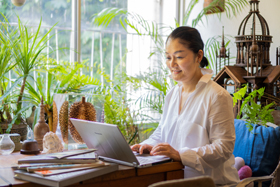 |
|
It was kind of a natural development, and then by 1999 we started having some projects here. At that time actually, my plan was to spend some time in Bueno Aires, Argentina to spend some time learning how to dance the tango and experience some of the exotic culture there. But because we had this project, I volunteered to come and set up the office in Singapore. That’s how I came here.
I lived in Tokyo all my life. But then I went to graduate school in the US, and then after that I went to Budapest, Hungary and then Canada for just a few months. I’m used to moving around, not being grounded in one place for many years. After 5 years in Tokyo, between 1995 and 2000, I also felt that it was time to move somewhere different. My family, well, they were forced to accept the nature that I had. JCC: How did you feel about Singapore when you moved here, compared to Tokyo? Was there any culture shock? R: Well, it wasn’t like I just suddenly moved to Singapore without knowing anything about the country. I started travelling to Singapore around 1997 or 1998. But actually, what was interesting is that Singapore was my first overseas trip with my family, when I was a young child. That was in 1976. I vaguely remember the smell of the tropics. I vaguely remember the Merlion, and the smell of durian, which is actually quite a distinctive memory. We stayed in Hyatt Regency, and I thought it was an interesting coincidence –at that time I never ever imagined that I’d be coming back to Singapore to actually live here, especially with my background as a musician. I was actually trained as a professional pianist. Before Singapore, I had spent more time in the US and Europe, so to be honest I didn’t know much about Singapore while I was growing up. Before joining LPA in 1995, I decided to drop music completely and pursue something else. I did a backpacking trip to India and Sri Lanka for 3 months. I did not pass through Singapore on that trip, but my 3 months in South Asia was totally different from how I grew up and my background in Western classical music. It opened up a new vision to life. |
|
Then, I joined LPA while Mr. Mende was interested in expanding to different Asian cities so I was always open to appreciate the environment. I wouldn’t say there was any culture shock or anything because I mean, we came to Singapore from time to time and I got to know the people. We felt that at that time, Singapore was really, in terms of design and art, ready to open up to something new and evolve towards a more cultural and artistic environment.
JCC: Did you observe any changes in the architecture, design of spaces in Singapore throughout the years you’ve travelled to and stayed in Singapore? |
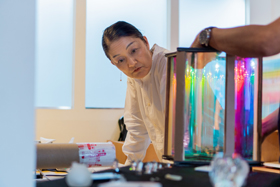 |
|
R: Of course. I have experienced and observed the transformation and evolution, and I can trace it through my writing. I have been actively reporting and writing about the design and architecture of Singapore to Japanese design and architecture magazines. When I first came here, one of the biggest news in architecture was that this architecture firm, WOHA, had won the competition to design MRT stations. Then there was also another competition actually, for Duxton Plain Housing. There was a public design competition and a local architecture firm, Arc Studio, won the competition. I remember going to the URA (Urban Redevelopment Authority) building where they hosted an exhibition showcasing all the competition entries. It was very interesting to see that some Japanese architects entered the competition as well but it was nice that the young Singapore architects won the competition.
It was when I strongly felt that Singapore was about to embark on a journey to promote young blood in the architectural and design world. Before coming to Singapore, I was only aware of some of the older generation - perhaps we can call them the pioneer generation - of architects who were very well-respected who were mostly educated in Europe, in the United Kingdom, and maybe in the US. But after coming to Singapore, I started seeing and interacting with the younger generation of architects. Another interesting thing is that I came across then was the magazine iSH. It was published by the young architecture graduate, Kelley Cheng. She started this design magazine called iSH in 1998. I went to visit an architect’s office where we were working on projects, and I saw the magazine and found it very interesting because around that time, iSH was very stylish and different from the conventional architecture magazine. I was introduced to Kelley herself, and since then we have become friends. These 20 years, Kelley, and Richard (Hassell) and Mun Summ (Wong) from WOHA have contributed so much to the design industry in Singapore. They have had a strong influence on how Singapore design, architecture, and the landscape changes. |
| I think the design and architecture industry has changed so much in the past 20 years compared to the previous 20 years in Singapore. This is because the basic infrastructure has matured. From 2000, the government had this Renaissance City vision. The basic idea is to promote art and design. I think I came to Singapore really at the right time, when the Singapore culture, design and art scene was about to evolve and transform into the new era. Through my work with LPA, interactions with the great architects here, and also through my writing about design, art, and architecture to Japanese magazines, I feel like I have witnessed the transformation of the city. | 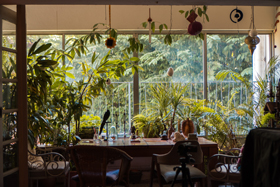 |
|
LPA too has done so much work. For my first project as someone representing LPA, I was all by myself. Although Japanese architecture and architects are very well-respected in Singapore, very little is known about lighting designers, for example, lighting design as a profession, and the role of lighting design. Hence, I thought that it was very important to organise some sort of public talk event to the architecture community in Singapore to share what architecture lighting design was all about. My role with LPA is to of course expand our worksphere, but at the same time it is to get more people to recognise the importance of lighting design.
At that time, we met Dr. Milton Tan, the head of the NUS Architecture Department. He had a very good understanding and appreciation of lighting design, and he thought it was a very interesting and important profession to add to the Singapore design landscape. That’s when I suggested we organise a talk with Mr. Toyo Ito, who had then just completed the incredibly beautiful project at the Sendai Mediatheque, a new kind of library in the city of Sendai where LPA was the lighting consultant. For this project, lighting took a very important role. Because the building is transparent, the lighting can totally change and transform the space into something very special, especially at night. We organised this talk event at NUS in early 2001 and this event drew the attention of the entire architecture community in Singapore. NUS sent out the invitation not only to students, but also to developers, and government agencies like URA, JTC Corporation, and also to all the architects. I remember seeing these big names like William Lim, Kerry Hill, who came to see Mr. Toyo Ito and to hear him talk. Mr. Mende and Mr. Ito had a lecture about how lighting can play a role in architecture and I believe it helped the architects, and perhaps some of the developers understand how lighting design can contribute to the building space. |
|
JCC: Could you tell us some of the significant projects that you and LPA were involved in? For example, those in the CBD and the Marina Bay area that won resident design awards.
R: When I first came to Singapore, Singapore was in a big recession. Private development was quite slow at that time but because of the government’s strong leadership, some prominent developments such as the National Library, Supreme Court, and One North were initiated. One North was a very interesting project for us because the master plan was developed by Zaha Hadid. Working on the lighting for this was very challenging and interesting. |
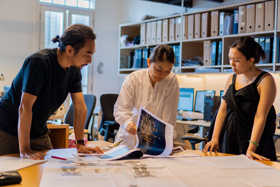 |
|
One of our very early assignments was the National Library and the Supreme Court. The architect for the National Library was Dr. Ken Yeang. Although he’s Malaysian, he has been talking about bioclimatic architecture, so he is very suited to designing architecture within this climatic condition. We met Ken before I came to Singapore, and he was the one that actually really inspired me so much with his vision of architecture and design that is very specific to this climatic condition, which is very different from the kind of architecture and approach that I was used to in Japan. Getting to know someone like Ken Yeang opened up my vision to, and helped me appreciate the possibilities of architecture and design in this part of the world.
For the National Library project designed by Ken Yeang, he proposed numerous ecological design features. To respond to his design idea, we also proposed, nearly 20 years ago then, the usage of solar panels to contribute to energy saving. At the time, our proposal was turned down flat and everyone was laughing at me: “Solar panels and solar energy - it’s a good idea but it’s too expensive. No way.” Then, after maybe 5 years, the government introduced the green mark initiative. They starting putting a lot of emphasis on sustainability and the energy scheme in the construction industry. That’s one of the interesting episodes of how Singapore transformed very fast according to the government’s vision. Soon after, we learned that URA was also considering a lighting master plan of city centres like Orchard, Bugis, the Marina Bay area, and the Singapore River area. URA invited a few international lighting consultants to give some proposals and ideas of what the lighting master plan should be. We won this competition because we were already here, and we understood that the lighting master plan required understanding of the culture. We also knew that climatic condition is very important. |
|
The URA envisioned night-time to be a more enjoyable time to go out for a stroll because the daytime is so hot. This was a very, very challenging project for us. Not only did we have to work on the design to complement a single architecture, we had to work on the city scale - designing, suggesting, and proposing how lighting can shape the city.
JCC: You mentioned that 5 years ago, your suggestions towards sustainability and energy saving were not accepted. However, 5 years later, it became a priority. Do you feel that you contributed to any of those changes in Singapore? |
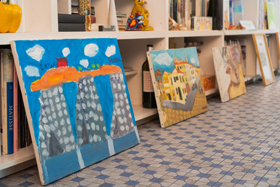 |
|
R: Yes. In the end, design always goes back to sharing your forward-thinking thoughts with society, right? I believe that it’s part of the responsibility of designers and artists to make places better. However, this lighting master plan is also not just also about engaging forward-thinking ideas but also very simply for addressing visual comfort and balance (in the city). It’s practical, and the good thing is that the Singapore government also has a strong vision in the area of urban planning.
Basically, our role as lighting designers is to complement. Let’s take Orchard for example. The government vision for Orchard is for the area to offer the best shopping experience in Singapore, so our lighting master plan has to cater to give it an inviting and uplifting mood. Whereas a place like the Singapore River, it’s about complementing the water. After working on the master plan, we were also gave similar advice to Osaka city on how to appreciate lighting on the riverside as we did with the Singapore River. The previous mayor, Mr. Hashimoto (Tooru Hashimoto, Mayor of Osaka city from 2011-2015) wanted to learn how the lighting plan of Singapore was conceived so we gave a tour to Mr. Hashimoto to show him how the plan was developed and implemented. JCC: Besides business activities, LPA has also been involved in non-profit activities such as organising talks to promote lighting as well as Japanese culture. Tell us more about some of the events you have held at JCC. R: Besides doing lighting design projects, we always push for social engagement work as we believe it is important to educate the public on what is good design and introduce ways to interact with and appreciate lights. To do that, we have been doing many non-profit activities under the programme ‘Lighting Detectives.’ With Lighting Detectives, we have organised many workshops and exhibitions in Singapore since 2000. |
| With JCC, we have also organised some very interesting workshops. The first workshop we organised with JCC was the Candle Light workshop in 2011. We also organised a Candle Light event at Marina Bay. JCC worked with us to organise a lantern-making workshop. It was so nice to see people gathering because we also do enjoy crafting and making things together with the public. The idea was also to use recyclable materials like empty plastic bottles and other materials you can find around you to craft the lanterns. We made a parade with these hand-crafted lanterns too. | 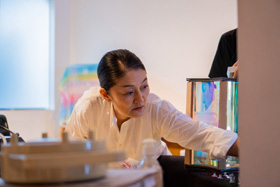 |
|
This energy-saving event started in Tokyo originally, but we brought it to Singapore and organised it for a couple of years. In the first year, we engaged a lot of children to the lantern-making for the parade. With this workshop at JCC, we got quite a number of adults to participate in the workshop.
JCC: What did you want the Singaporeans to learn from this event in Tokyo? R: We wanted Singaporeans to learn the simple enjoyment of making lanterns with materials around you. It is fun to turn off the light and see that the lantern can create a pleasant and pretty environment. The idea of candle light is to turn off the light and appreciate the intimate time of night. We also requested for all the restaurants at Marina Bay (when we organised it) to totally turn off their lights for the event; we all placed the candles in the shopfronts and restaurants and created a beautiful atmosphere. I wouldn’t say that people during that time didn’t think about lighting design as we have been doing different activities like Light Up Ninja (a workshop for kids), but I think it is important to constantly reach out to the public to share the idea of appreciating lights and playing with lights. JCC: Do you have any thoughts on the architecture of JCC? R: Black and white bungalows are one of my favourite kind of spaces in Singapore, so when I first learnt of JCC’s opening, I was so amazed and thought how lucky JCC was to have a beautiful space within the city. I like the openness, and the natural feeling of the space. It is a very good place to organise intimate and creative events as it is not so grand and bare. |
|
JCC: Could you tell us more about your family?
R: A year after I came to Singapore, the great lifestyle magazine BRUTUS had a special issue on Bali. I was given this amazing assignment to write about the architectural design and the creator behind all these nice resort hotels and beautiful spaces in Bali. I had the privilege of spending many weeks in Bali to meet some designers and architects working in tropical architecture and design. That’s when I was introduced to Made Wijaya, an Australian landscape designer who created all these beautiful resort hotel gardens. | 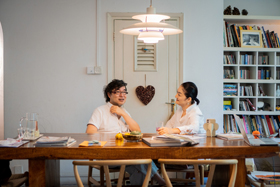 |
|
I approached him when I was researching designers and architects in Bali and his name came about. When I was sharing my ideas on Bali to young designers at LPA, one of them told me that her classmate (Chang Huai Yan) at NUS was also an intern for Made Wijaya in Bali. That classmate ended up becoming my husband. I was introduced to him before I went to Bali, but the first time I met him was in Bali. It took us a while to become official because at that time, I was madly in love with someone else.
He is 12 years younger, and he had started up his own studio with other classmates who were all NUS Architecture graduates. He draws well, so Made invited him to work with him in Bali and he spent some time in Bali before he came back to Singapore to start his office. They used a residential home in Telok Kurau to create a beautiful tropical-style office space. My husband grew up with anime. I think his introduction to art and design was through watching anime. Before he met me, he was a cartoon artist, and the reason he studied architecture was initially not so much because of his appreciation of architecture but because he wanted to be creative. His parents, as typical Chinese parents, didn’t allow him to pursue being a manga artist. He is now a landscape artist and runs a company called Salad Dressing. All these logos for events such as Light Up Ninja, Candle Light, and other exhibitions, were contributed by him. It has been a pleasure seeing how my husband and his team evolved. JCC: How do you keep Japanese culture at home? R: I cook a lot of Japanese food. My suitcase is full of Japanese food every time I travel to Tokyo. I have also been speaking to my daughter only in Japanese ever since she was born, and we sent her to the Japanese school. I think it is a natural thing to me. No matter where I am, I am strongly Japanese: I write in Japanese, I think in Japanese... |
| One of the things I think is important is to have a core language. The great thing about Singapore is that people are multilingual and Japanese have great respect for that. At the same time, I believe that having one language you know really well is important. As someone that was born and grew up in Japan, the Japanese language is very important. My husband also agrees, despite not speaking Japanese, and instead of expecting her to pick up Chinese or English, he wants to keep Japanese as her primary language. | 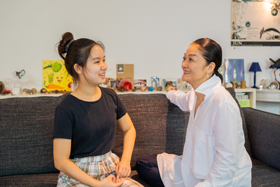 |
|
JCC: From your personal point of view, are there any points Singapore and Japan can learn from one another? Is there anything they do that complements each other?
R: I might have said it earlier but what I appreciate about Singapore very much is the government’s strong vision. Anyone can set a vision, but to implement and achieve this vision is not easy. The lighting master plan was launched in 2005, and through my work with LPA, I have seen the clear evolution and achievements of the implemented lighting plan. Now you can see that Singapore is known for its beautiful nightscape. It is not a spontaneous thing but an achievement based on planning. For that, I have great respect. I couldn’t have imagined when I first came to Singapore that you would now have the amazing National Gallery of Singapore and other art institutions and great exhibitions. That was also achieved because of planning. That is something we all have great respect for. We can’t compare the speed because Singapore is small and Japan is big, but this is what I appreciate about Singapore. I think that in Japan we have a longer process to make things happen. I think when we have a goal, we need to look at the best way to achieve the goal but in Japan, we are not brought up this way and there are a lot of things which are unnecessary. In Singapore, you see a lot of young people setting up restaurants and becoming celebrity bartenders and chefs. I think it is fun, and nice to see young energy appreciated but in Japan it is hard to see this because we believe in long years of training discipline and craftsmanship. Sometimes it is difficult for young people to showcase their work because people will see that you don’t have enough experience to be able to do a showcase. This same thing applies in design as well. But I also believe that we can somehow hybridise these new, fresh ideas of what young Singaporeans can offer with the kind of Japanese sense of discipline and pursuit of perfection. Instead of going parallel ways and accepting our cultures are different, I think there is greater potential and opportunity in hybridising. |
|
There is a lot interaction (between Singapore and Japan) through the JCC’s activities introducing Japanese culture to Singapore audiences, people travelling to Japan, and Japanese coming to Singapore. I think people have digested the differences, and we can look forward to seeing a new creation being developed in the next few years.
Look forward to our next issue, where our conversation with Reiko Kasai continues with Wong Mun Summ and Richard Hassell of WOHA. Watch the interview here. | 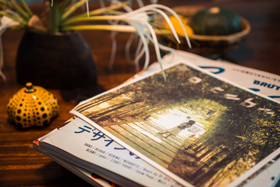 Reiko Kasai's daughter featured on cover of pamphlet (landscaping of the place was done by her husband) |
|
* All photos used in this article are taken by JCC / © JCC |
|
Japan Creative Centre 4 Nassim Road, Singapore 258372 +65 6737 0434 / jcc@sn.mofa.go.jp https://www.sg.emb-japan.go.jp/JCC/ Nearest parking at Orchard Hotel & Delphi Orchard |
 |